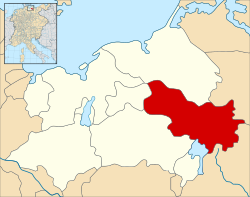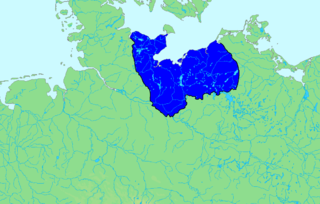Lordship of Werle Herrschaft Werle(de) | |||||||||
|---|---|---|---|---|---|---|---|---|---|
| 1235–1436 | |||||||||
 The Lordship of Werle at the time of the Hohenstaufen Emperors (circa 1250). | |||||||||
 An anachronistic map of Mecklenburg in the early 14th century: Werle-Güstrow circa 1316 Werle-Waren circa 1316 Duchy of Mecklenburg Lordship/Principality of Rostock up to 1312 to Mecklenburg from 1320 | |||||||||
| Status | State of the Holy Roman Empire | ||||||||
| Capital | Werle | ||||||||
| Common languages | Middle Low German | ||||||||
| Government | Principality | ||||||||
| Historical era | Middle Ages | ||||||||
• Established | 1235 | ||||||||
• Partitioned: W-Güstrow and W-Parchim | 1277–1307 | ||||||||
• Partitioned: W-Güstrow and W-Goldberg | 1316–74 | ||||||||
• W-Güstrow partitioned to create W-Waren | 1337–1425 | ||||||||
• Reverted to Mecklenburg | September 7, 1436 | ||||||||
| |||||||||
Werle (or Wenden) was a fiefdom in the Holy Roman Empire that was founded in 1235. In German it is known as a Herrschaft (usually translated as "lordship") or Fürstentum (principality). It was created in the partition of territories in Mecklenburg that followed the death of Henry Borwin II of Mecklenburg (died 1226).

The Holy Roman Empire was a multi-ethnic complex of territories in Western and Central Europe that developed during the Early Middle Ages and continued until its dissolution in 1806 during the Napoleonic Wars. The largest territory of the empire after 962 was the Kingdom of Germany, though it also came to include the neighboring Kingdom of Bohemia, the Kingdom of Burgundy, the Kingdom of Italy, and numerous other territories.
In the German feudal system, a Herrschaft was the fiefdom of a lord, who in this area exercised full feudal rights. It is the equivalent of the French term seigneurie and is often translated as "lordship" in English.

Fürst is a German word for a ruler and is also a princely title. Fürsten were, since the Middle Ages, members of the highest nobility who ruled over states of the Holy Roman Empire and later its former territories, below the ruling Kaiser (emperor) or König (king).
The royal (fürstlich in German) House of Werle was a spur line of the House of Mecklenburg line of the Obotrites. The Fiefdom of Werle lay in the area around Güstrow in today's Mecklenburg-Western Pomerania, Germany, and stretched eastward to Müritz. It was named after the then-capital Werle, now a village in the municipality Kassow, Rostock district.

The House of Mecklenburg, also known as Nikloting, is a North German dynasty that ruled until 1918 in the Mecklenburg region, being among the longest-ruling families of Europe.

The Obotrites or Obodrites, also spelled Abodrites, were a confederation of medieval West Slavic tribes within the territory of modern Mecklenburg and Holstein in northern Germany. For decades, they were allies of Charlemagne in his wars against the Germanic Saxons and the Slavic Veleti. The Obotrites under Prince Thrasco defeated the Saxons in the Battle of Bornhöved (798). The still heathen Saxons were dispersed by the emperor, and the part of their former land in Holstein north of Elbe was awarded to the Obotrites in 804, as a reward for their victory. This however was soon reverted through an invasion of the Danes. The Obotrite regnal style was abolished in 1167, when Pribislav was restored to power by Duke Henry the Lion, as Prince of Mecklenburg, thereby founding the German House of Mecklenburg.

Güstrow is a town in Mecklenburg-Vorpommern, Germany. It is capital of the Rostock district.
The fiefdom collapsed several times into separate dominions. In 1277 it was divided among the sons of the first lord, or Herr in German, into Werle-Güstrow and Werle-Parchim. In 1307, both were reunited by Nicholas II, but they were divided again in 1316 into Werle-Güstrow and Werle-Goldberg. In 1337, Werle-Waren split off from the Werle-Güstrow line. With the death of the William, the last lord on September 7, 1436, the fiefdom once again reverted to Mecklenburg. The title of Lord of Werle was thenceforth carried by all rulers of Mecklenburg. Werle is represented in one of the seven fields of the coat of arms of Mecklenburg.
William of Werle, was co-regent of Werle from 1418 to 1425, then the sole ruler from 1425 until his death. After 1426, he called himself "Prince of the Wends". He was a son of Lorenz of Werle-Güstrow and his wife Matilda of Werle-Goldberg.

